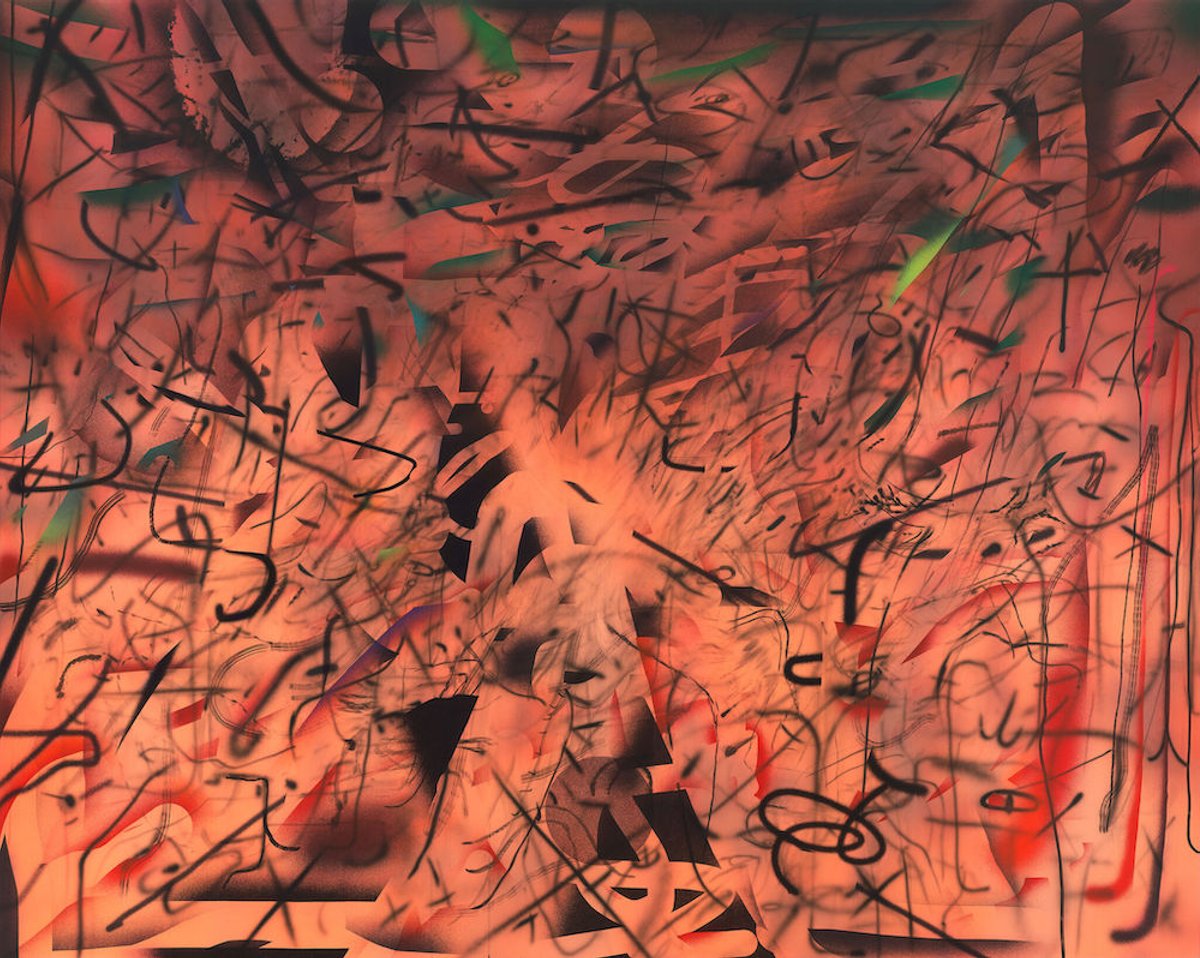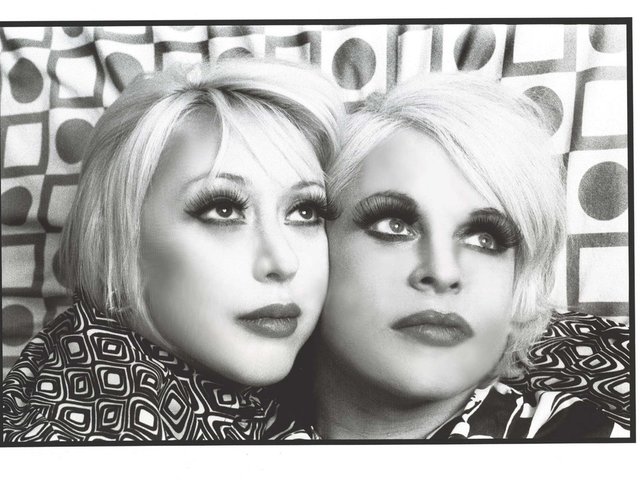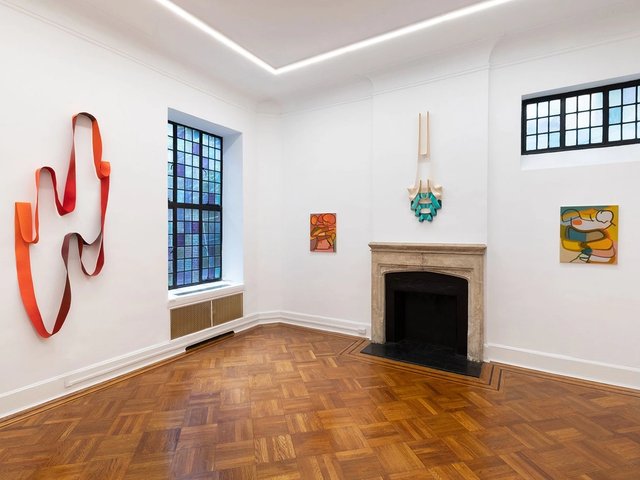Julie Mehretu
Until 8 August at the Whitney Museum of American Art, 99 Gansevoort Street, Manhattan
Julie Mehretu’s massive mid-career survey—which has travelled from the Los Angeles County Museum of Art—includes more than 70 paintings and works on paper that date from 1996 to today. It offers a chance for viewers to track the progression of Mehretu’s style from early pieces that focus more heavily on mapping and drawing to her sprawling abstractions with innumerable layers of visual information. Some of the most recent works on view also smartly deal with contemporary social issues, as the process begins with photographs—one started with police in riot gear following the killing of Michael Brown, for example, while another began with images of climate change-related firescapes. These images are then blurred and erased beyond recognition before paint and other materials are stacked on, and are then sanded and erased, creating a pentimento surface where older layers peer through newer ones, together forming a cartographic world through which her complex artistic process can be traced.

Lucy Raven, Ready Mix (2021) Bill Jacobson Studio, courtesy of Dia Art Foundation
Lucy Raven
Until January 2022 at Dia Chelsea, 535 West 22nd Street, Manhattan
The Dia Art Foundation’s hub in Chelsea has reopened with a renewed purpose: to champion under-recognised artists and to serve as an information hub for all 11 of Dia’s long-term art sites. Dia’s goal in the revamped space is to keep artists’ works on display for as long as nine months or more, beginning with a film and two pairs of light sculptures commissioned from the artist Lucy Raven. Her black-and-white 50-minute film Ready Mix, shot at a plant in Idaho, records the transformation of minerals and binders into concrete and evokes the historical preoccupation of several Dia artists with the American West. The lights in her sculptures, part of a series titled Casters, will move continually in and out of synchronisation with each other in a cavernous space. The new space is an affirmation of the role that Dia has historically played in the area, where the foundation first established a presence in the 1980s and served as a pathbreaker in promoting work by such artists as Dan Graham, Dan Flavin and Jorge Pardo.
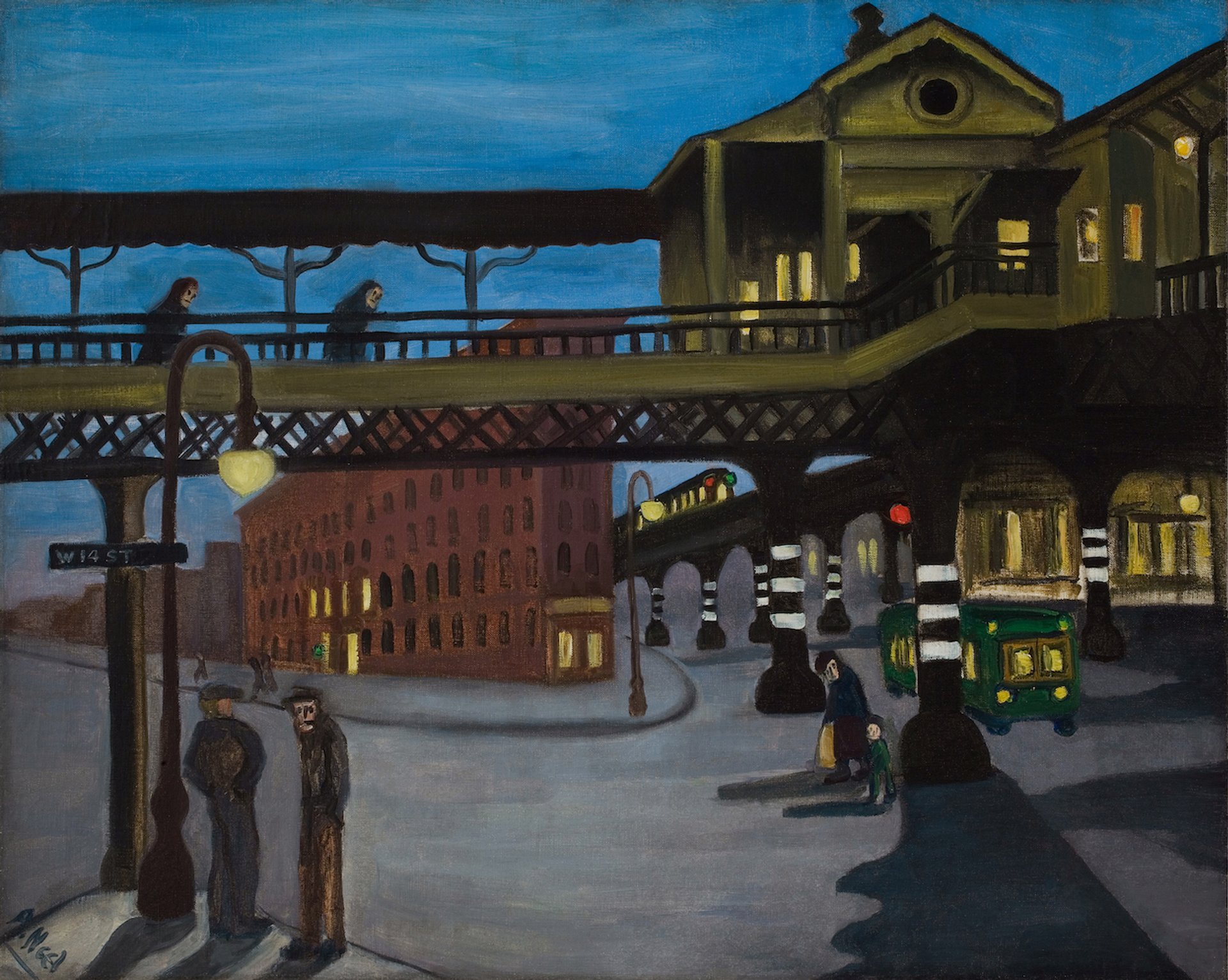
Alice Neel, Ninth Avenue El (1935) Cheim and Read, New York. © The Estate of Alice Neel
Alice Neel: People Come First
Until 1 August at the Metropolitan Museum of Art, 1000 Fifth Avenue, Manhattan
The retrospective chronicles six decades of Alice Neel’s (1900-1984) prolific career, from her portraits of New York’s global diaspora to her visceral depictions of motherhood. Some of the most striking pieces in the show are the nude portraits Neel painted of pregnant women—a subject she said was missing in Western art—that capture the psychological and physical weight of the moment, like the painting Margaret Evans Pregnant (1978) depicting a friend of the artist who was expecting twins. The show also examines Neel’s lifelong engagement with New York, including portraits of her neighbours in Spanish Harlem, and her work for the Works Progress Administration during the Great Depression. Neel stuck to an Expressionist painting style in an era where Abstraction reigned, and was “ambitious at a time when women were not expected to be ambitious, or to be artists”, says Kelly Baum, the Met’s Cynthia Hazen Polsky and Leon Polsky curator of contemporary and Modern art.
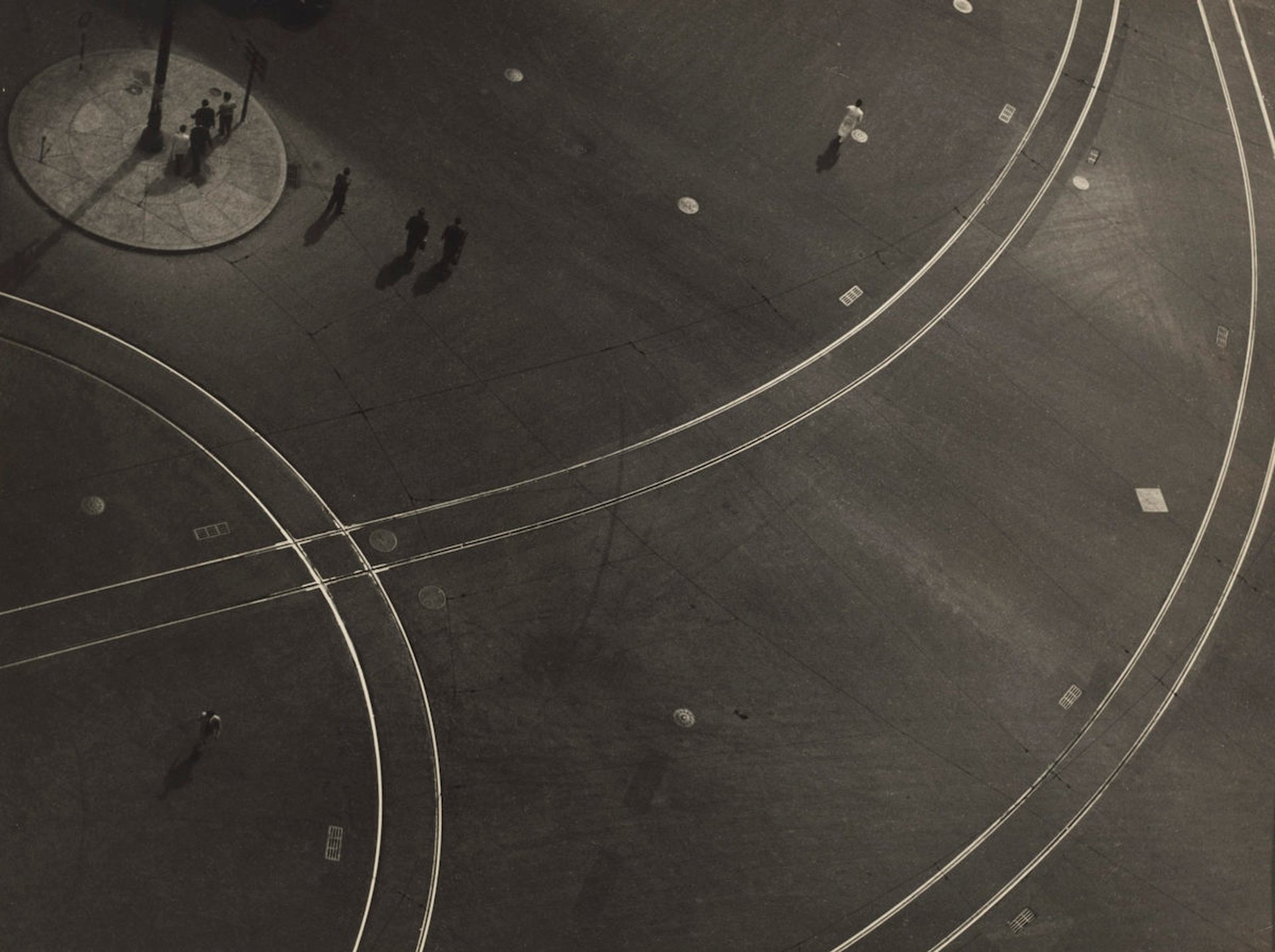
André Carneiro, Rails (Trilhos) (1951) The Museum of Modern Art. © 2020 Estate of André Carneiro
Fotoclubismo: Brazilian Modernist Photography, 1946–1964
Until 26 September at the Museum of Modern Art, 11 West 53rd Street, Manhattan
The prolific but little-known Foto-Cine Clube Bandeirante, a collective of Brazilian amateur photographers, was founded in São Paulo in 1939 and produced captivating work that remains largely unseen by audiences outside Brazil. The exhibition reveals the compelling relationship between the group and MoMA, which dates back to 1948, when the photographer Thomaz Farkas—a founding member of the collective—travelled to New York and met Edward Steichen, then the director of the museum’s photography department. The show comprises more than 60 photographs that reveal “a chapter of art history that has been woefully neglected”, says the MoMA photography curator Sarah Meister, and also aims to rewrite the “presumption that amateur photographic practices are hopelessly imitative”. She adds: “The act of re-evaluating the status of the amateur is one that holds promise for recuperating other aspects of photography’s history—and many other neglected histories.”
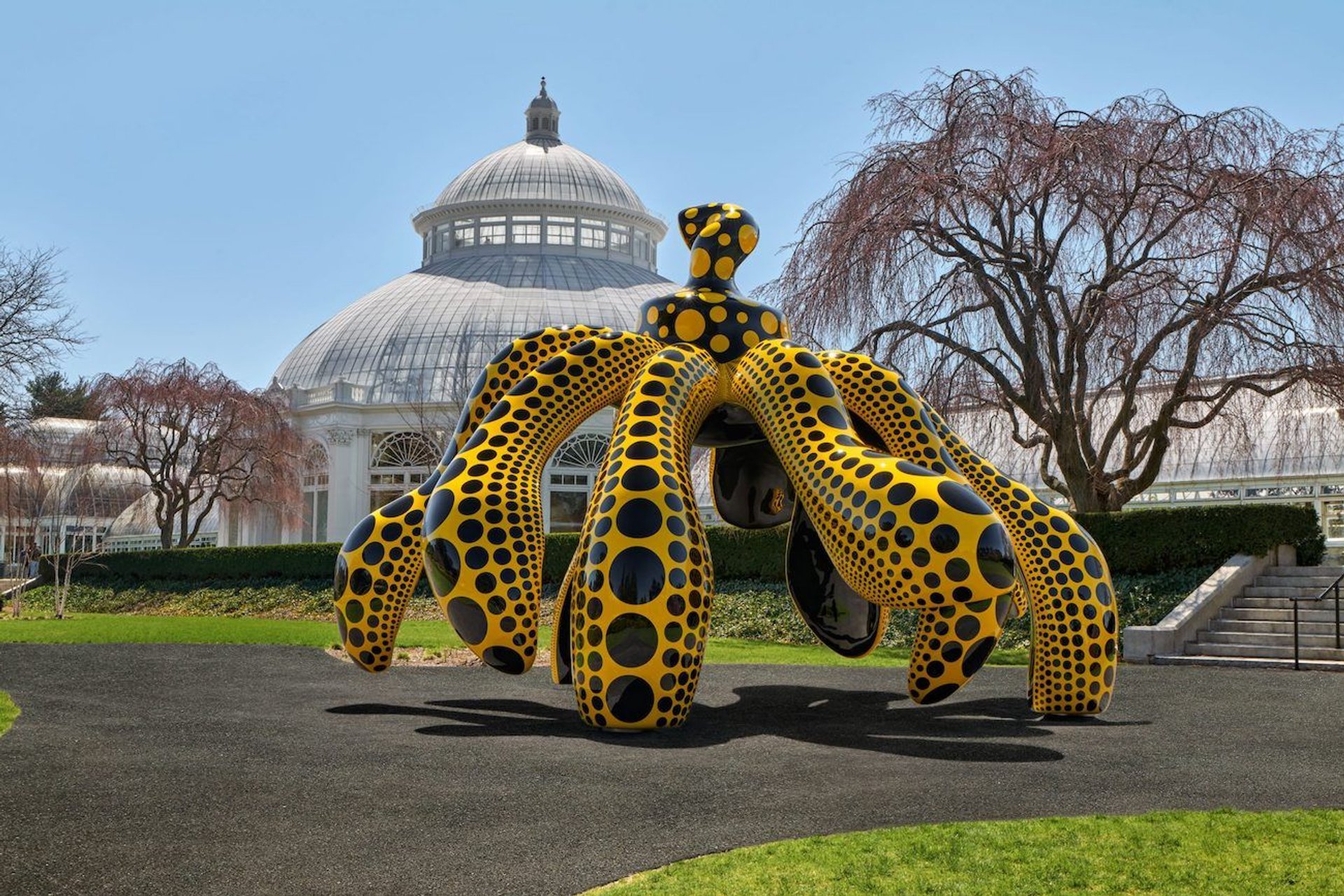
Yayoi Kusama, Dancing Pumpkin (2020) at the New York Botanical Garden Courtesy of Ota Fine Arts and David Zwirner. Photo: Robert Benson Photography.
Yayoi Kusama: Cosmic Nature
Until 31 October at the New York Botanical Garden, 2990 Southern Boulevard, The Bronx
The long-awaited exhibition engulfs the indoor and outdoor spaces of the 250-acre garden with the Japanese artist Yayoi Kusama’s whimsical sculptures and installations. The show dramatically transforms some cornerstones of Kusama’s well-known portfolio, such as the monolithic Dancing Pumpkin (2020) in which the artist has reimagined her classic pumpkin sculptures into an octopus-like biomorphic figure. It also features new iterations of past works like Narcissus Garden, a work comprising a pool of reflective orbs that was first installed at Fort Tilden in 2018, and one of the artist’s celebrated Infinity Rooms, which is still only visible from the outside due to pandemic-related restrictions. Kusama shared a message about the exhibition last month: “Dancing through our universe are noble souls whose magnificent forms are saturated with mystery. I invite you to explore the endlessly expanding ode to the beauty of love that is my art.”
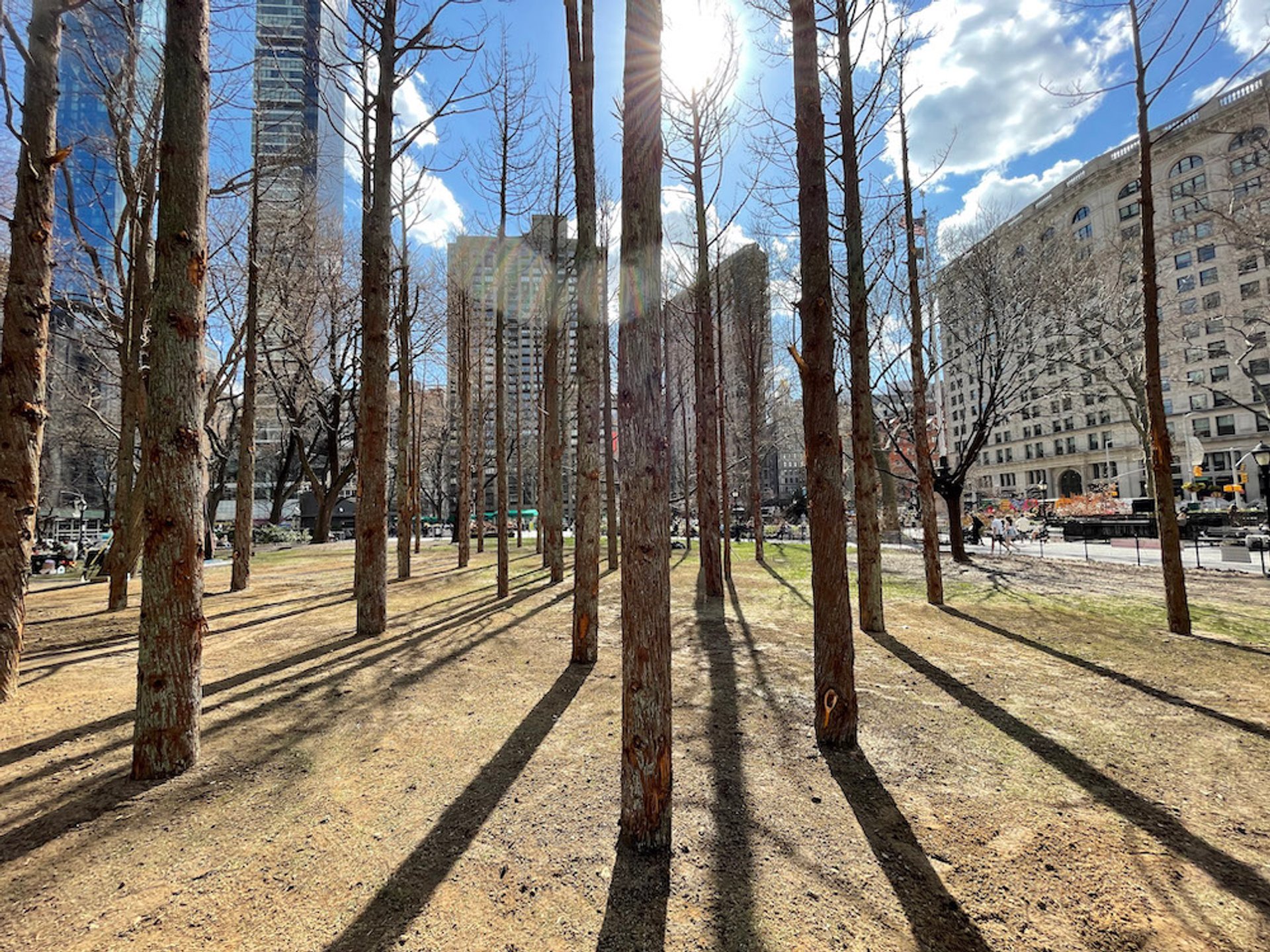
Maya Lin, Ghost Forest (2021) Courtesy the artist and Madison Square Park Conservancy. Photo: Maya Lin Studio
Maya Lin: Ghost Forest
Until 14 November at Madison Square Park, Manhattan
The immersive installation, which was slated to open in June last year but was postponed until this month due to the pandemic, visualises the bleak effects of climate change. The US artist and environmental activist Maya Lin has created a “forest” of around 50 towering desiccated white-cedar trees that are planted in the oval lawn of the park to create an ominous micro-landscape that references the impact of climate change on the environment. Lin has also developed a soundscape that will allow visitors traversing the installation to listen to the calls of endangered and extinct species once native to Manhattan. The dead trees were sourced from a restoration project located within the New Jersey Pine Barrens, a site spanning more than a million acres where “ghost forests” are increasingly lining the waterways due to saltwater infiltration from rising sea levels and other climate change-related causes. While patches of dead vegetation tend to recover over time, experts believe the Pine Barrens will never fully recover.
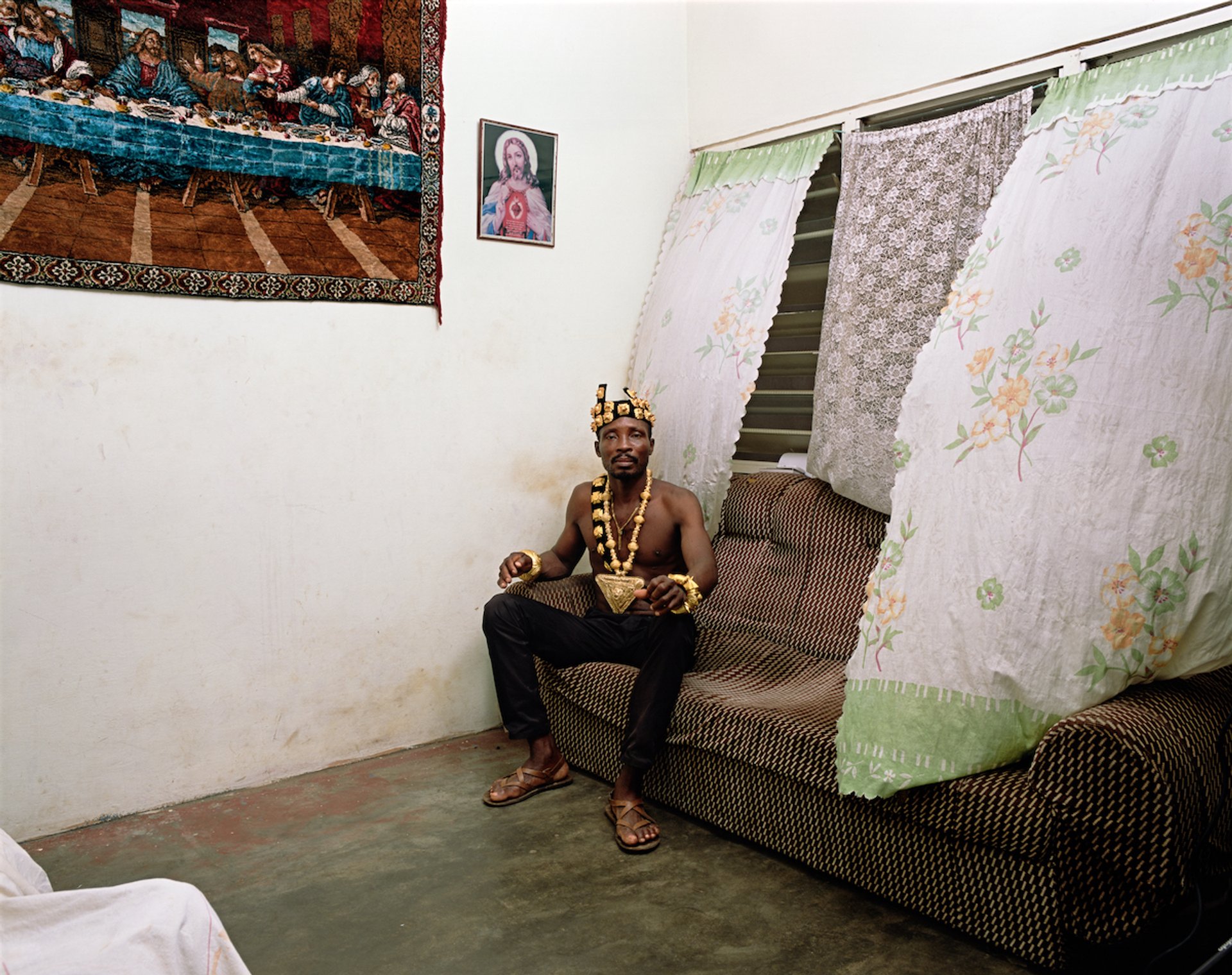
Deana Lawson, Chief (2019) © Deana Lawson, courtesy of Sikkema Jenkins & Co., New York; and David Kordansky Gallery, Los Angeles
Deana Lawson: Centropy
Until 11 October at the Solomon R. Guggenheim Museum, 1071 Fifth Avenue, Manhattan
The New York-based photographer Deana Lawson, best-known for her naturalistic images centred on the Black diaspora, including her Hellenistic depictions of Beyoncé and other Black celebrities, was awarded the $100,000 Hugo Boss Prize in October last year, marking the first time a photographer has received the biennial prize. The subsequent exhibition features a selection of captivating large-scale photographs—including recent and never exhibited works—that demonstrate Lawson’s humanistic depictions of her subjects, and some works that are embedded with holograms. In a short film commemorating the award, Lawson says her work aims to “image the mythic realm or use the person as a vehicle to represent an entity beyond what is actually present”. Later this year, the Institute of Contemporary Art Boston will present the first museum survey devoted to the artist, comprising a vast collection of works spanning nearly two decades.
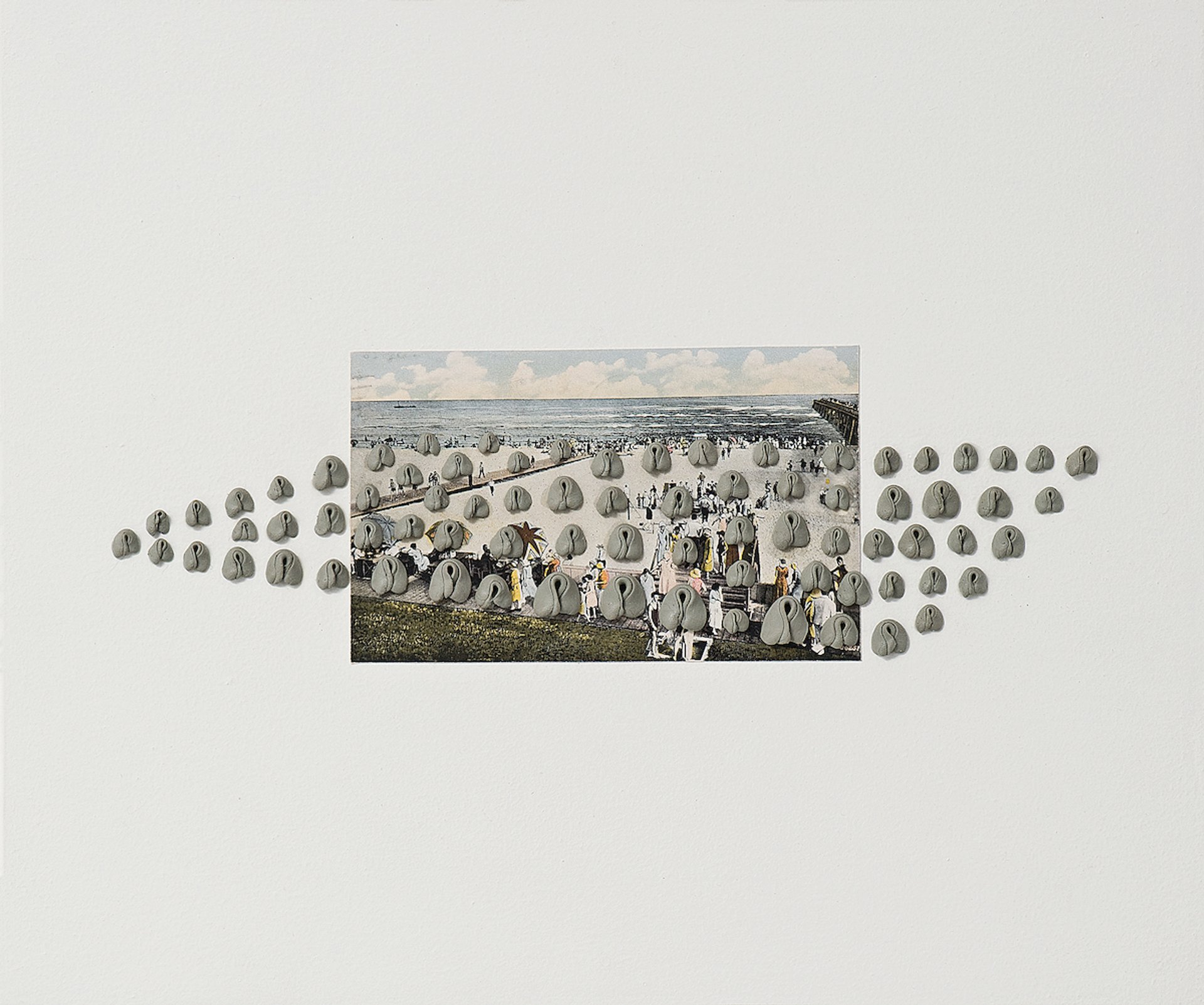
Hannah Wilke, Atlantic City Boardwalk (1975) Hannah Wilke Collection & Archive, Los Angeles. Courtesy Alison Jacques Gallery, London.
Eva Hesse and Hannah Wilke: Erotic Abstraction
Until 18 June at Acquavella Galleries, 18 East 79th Street, Manhattan
This is the first two-person show ever organised to put the work Eva Hesse and Hannah Wilke in dialogue with one another. The two artists, both based in New York and both working in the same era, each shifted their focus to sculpture in the 1960s. The rejecting the popular models of the time such as Minimalism and instead sought new paths with materials that were rarely if ever seen in the world of fine arts at the time. Among the many ways the two artists were in concert with one another, the exhibition shows how a few years after Hesse established that liquid latex—which had only recently been made available—was a material one could elevate to the high arts, Wilke began exploring it as well. There are other great areas of overlap between the two artists, including explorations of rhythmic repetitions and patterns in their sculpture, as well as inquiries into how material can invoke the body. Though both died fairly young—Hesse at 34 from a brain tumor that some speculate was caused by fumes from the materials used in her sculptures, and Wilke at 52 from a bout with cancer that she ardently documented in her work—the show emphasizes not just how the two may have influenced each other, but how the lexicons they developed went on to widely expand the world of contemporary sculpture.

Agnes Martin, Desert Flower (1985) © Estate of Agnes Martin /Artists Rights Society (ARS) New York
Agnes Martin: the Distillation of Color
Until 26 June at Pace, 540 West 25th Street, Manhattan
The monographic exhibition, a sweeping and rapturous presentation of the celebrated Minimalist painter, features a selection of paintings Agnes Martin made during the 1970s to the 1990s, after she re-emerged from nearly a six-year hiatus from art making. The pioneering artist left New York in 1967 after a series of hospitalisations and mental breakdowns, and embarked on a self-imposed period of isolation in New Mexico. She reappeared in 1973 with a renewed spiritual awareness inspired by the profound void of the desert landscape. The gridded patterns, a signature of her earlier pieces, had loosened, and were replaced by rhythmic bands of colour that evoke the sublime. After producing a series of black paintings in the late 1980s, Martin returned to these metaphysical striped paintings until her death in 2004.
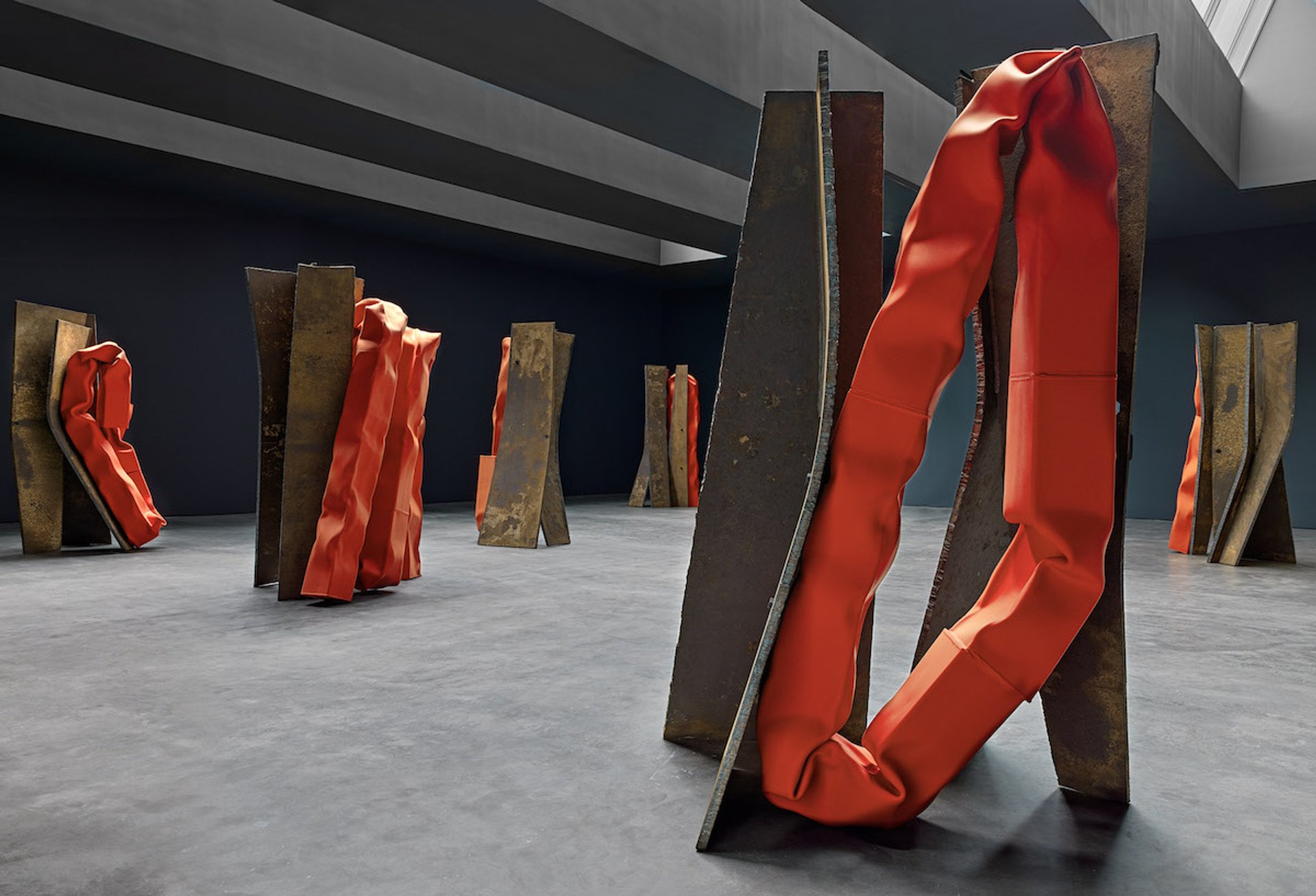
Installation view, Carol Bove: Chimes at Midnight at David Zwirner Maris Hutchinson. Courtesy David Zwirner.
Carol Bove: Chimes at Midnight
Until 19 June at David Zwirner, 537 West 20th Street, Manhattan
New works by Carol Bove are currently on view in three locations throughout Manhattan—in David Zwirner’s Chelsea and Upper East Side locations and in a recent commission at the façade of The Met. The Chelsea exhibition debuts seven new sculptures. Each work is roughly ten-feet tall and made from steel tubing which is manipulated and painted with bright urethane paint (think the sheen and hue of a sports car) and then propped against sheets of salvaged hot-rolled steel. As is the case for the sculptures in all three shows, much of the magic here comes from the ways in which they seem to transcend their materials, as Bove’s three-dimensional compositions imbue the steel with a gravity-defying sense of grace and lightness. In this way, the works defy logic and make perfect sense all at once. Start in Chelsea, make your way to the Upper East Side, then stop off and meet a friend on the steps of The Met.
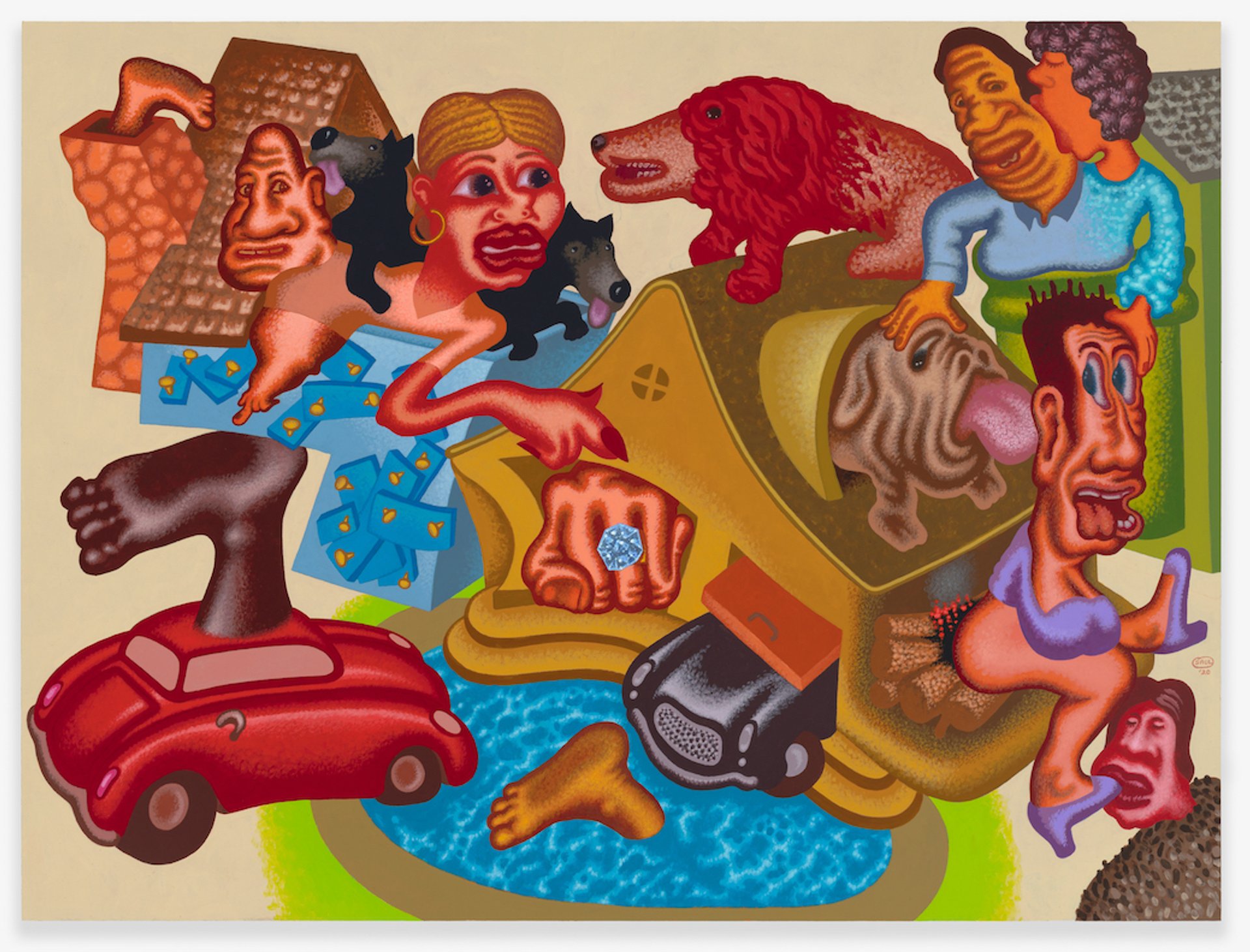
Peter Saul, Neighborhood Gossip (2020) © 2021 Peter Saul / Artists Rights Society (ARS), New York. Courtesy the Artist, Venus Over Manhattan, New York, and Michael Werner Gallery, New York.
Peter Saul: New Paintings
Until 26 June at Venus Over Manhattan, 120 East 65th Street, and Michael Werner, 4 East 77th Street #2, Manhattan
In a two-part exhibition that comes on the heels of his New Museum retrospective, painter Peter Saul (now in his mid-80s) debuts 17 new paintings made between 2019 and 2021. Though billed as somewhat less overtly political than much of his work—Saul has spent a lifetime using absurdism to explore politics in his paintings, and his canvases have been home to highly stylized likenesses of nearly every American president since Nixon—these works are hardly neutral. In them, Saul uses his instantly-recognizable style, which fuses movements including Surrealism, Pop, the Bay Area’s Funk Art, and Chicago’s Hairy Who, into something that belongs to Saul alone, to explore themes of climate change, the pitfalls of capitalism, art history, and the foibles of identity. Landing somewhere between Social Realism and MAD Magazine, it’s safe to say that Saul is a master at this point.
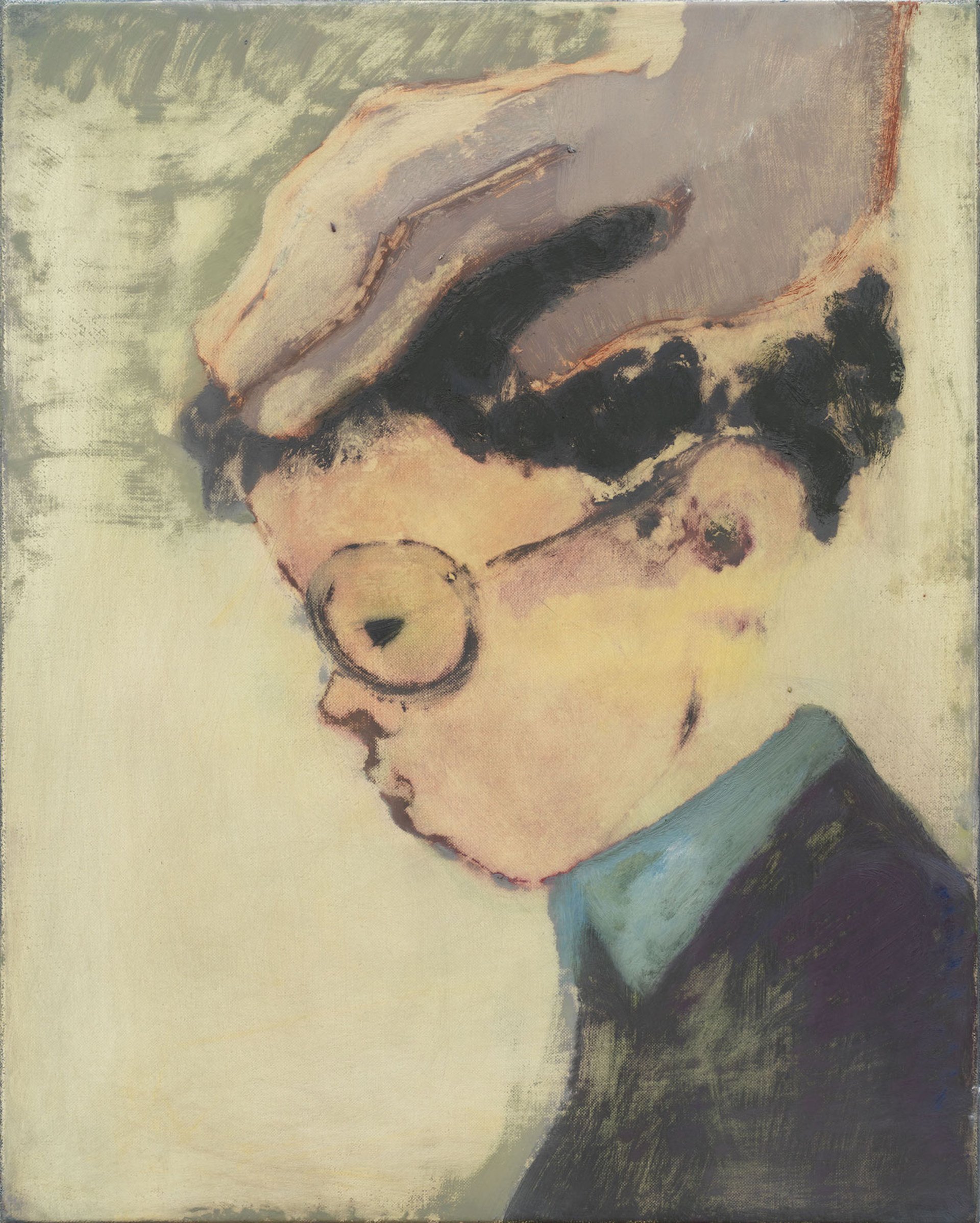
Sanya Kantarovsky, Face 15 (2021) Jeffrey Sturges. Courtesy Luhring Augustine.
Sanya Kantarovsky: Recent Faces
Until 12 June at Luhring Augustine, 17 White Street, Manhattan
The exhibition Recent Faces is just that—15 new, modestly-sized paintings of dreamy, melancholic faces carried out in Kantarovsky’s poignant and wondrous style. Titled simply Face 1 through Face 15 and painted in 2021 in oil and watercolour on linen, each work seems to contain a narrative world all its own, as if every face were a still moment from a novel. The works are a healthy reminder that every person we pass on the street is in the midst of their own narrative journey, a long ribbon of joy and suffering unfurling from the nursery to the cemetery. The paint is handled differently throughout, some works like Face 5 and Face 15 have a texture and quality of lightness that feels as if they were monotypes, while Face 13 melds different touches to give us a figure whose face and clothing feel thick and wet, while her hair barely floats atop the picture plane as if it were rust caused by the elements.


